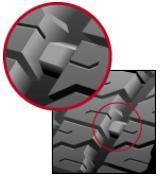Tyre Safety
Checking your Tyres
Tyres are a fundamental part of your vehicle. They are the only part of the vehicle that has contact with the road. Your tyres may have already saved you and your vehicle from sustaining serious damage or worse, many times over.
It is a fact, however, that they are often poorly maintained and seldom checked, sometimes inspected only during routine servicing or an MOT test.
Checking and maintaining your tyres on a regular basis is relatively straightforward and not particularly time-consuming and could save you time, money or even your life.
Here are a few simple tips and explanations, to provide you with the information needed to ensure that you achieve the best performance, the maximum wear and the safest possible motoring.
So, when is the most convenient time to check your tyres? As a suggestion, why not straight after it has been washed? This way, you will be able to see clearly the side-walls and surface area (and stay clean!). Soapy water over a tyre will often highlight any punctures!
First, use something you can kneel down on and follow these easy steps:
- With the handbrake on and out of gear lock the steering fully to one side. Switch off. This will enable you to see fully across the treaded area of the front tyres. Important: Many modern vehicles have particularly wide tyres. The innermost edge of the tyre can often wear away completely, while the remaining visible part of the tyre surface will appear faultless. Please check carefully – both front and rear.
- Now check the treaded area across the tyre. All tyres have what are called ‘tread wear indicators‘ located within the grooves of the surface across the central part of the treaded area. These are small raised blocks about 10mm in length and 2mm in height located all around the tyre. These indicators provide the way to assess the remaining tread depth on your tyre. The legal minimum depth required is 1.6mm. The indicators are raised to 2mm. Therefore, if any part of the tread block area is running flush with the indicators, your tyre has worn to a level where you should consider changing your tyres soon.


- Assuming there is ample tread left on the tyre, next you need to examine as much of the tread surface as you can. Older tyres and tyres which have stood for some time can suffer from material degradation. Examine carefully around the shoulders and within the grooves for signs of cracking and perishing. Sometimes a tyre can wear very unevenly. Your tyre may have perfectly legal tread at one spot and further round have none. A tyre that has uneven wear may be distorted or wrongly aligned. At the same time, look out for any deep and long cuts and any stones or other objects (remember your tyres run over all sorts of road conditions and objects). Samm stones can usually be prised off without much effort. Anything that will not come out may have penetrated the tyre and be causing a pressure loss (puncture).
- Now look at the side wall. If you have decorative wheel covers (trims), it is advised that these are removed them during checking. It has been found that some wheel trims can cause severe abrasive damage to the side walls, check for any marks if/where the trim meets the tyre. The walls are prone to damage from impacts, chafing along curbs, under inflation and tearing so look for abrasions, cuts or missing rubber. If you can see an abrasion mark running the entire circumference and it has worn away part of the letters and numbers, there’s a good chance that the tyre has a puncture or has been run under inflated for some time This is caused when the tyre is ‘pinched’ between the wheel and the road surface (run flat) By running the flat of your hand over the entire surface of the sidewall, you will be able to detect any bulges (a section where the rubber is protruding from the rest of the wall) caused by impact, a bulge represents serious damage to the structural integrity of the tyre.
- Within the outer rim of the wheel, you will find the valve. As much importance should be placed on this component as the tyre itself. If your vehicle has rubber type valves fitted, check for deterioration of the material. By gently moving the valve stem from side to side, look for cracking of the rubber around the base. Ensure that caps are fitted.
- Repeat this process for each tyre (don’t forget the spare) and pay attention to the areas that cannot normally be easily seen.
To re-cap, your vehicle requires attention if you find any of the following faults:
- Low tread depth
- Deterioration of the rubber – cracking & perishing
- Uneven tread wear – distortion of the tyre
- Deep cuts or sections of tread missing
- Embedded foreign objects
- Side wall damage & bulges
- Damaged/worn valve assembly
If all is well, make sure to check the tyre pressures!
If you are in any doubt, please remember that help is just a phone call away
